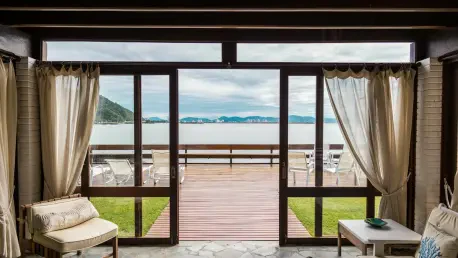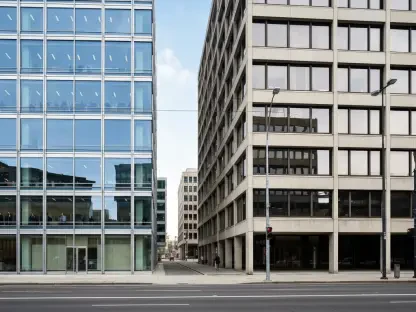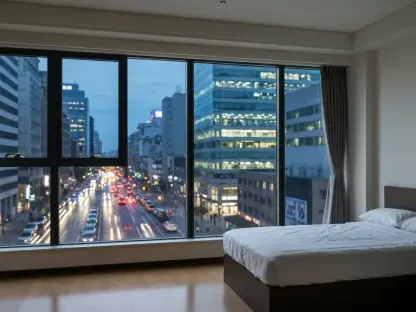Imagine stepping into a backyard that feels like it was plucked straight from the silver screen, where every detail exudes the warm, effortlessly elegant charm of a romantic comedy, captivating you with its inviting allure. The outdoor spaces in films like Something’s Gotta Give and It’s Complicated have captivated audiences with their blend of relaxed sophistication, blooming gardens, and inviting furniture that seems to whisper stories of long lunches and heartfelt conversations. These settings aren’t just beautiful—they’re emotional havens that inspire connection and comfort. For anyone looking to elevate their patio into a cinematic retreat, this guide offers a roadmap to capturing that timeless aesthetic. It’s about creating a space that feels both luxurious and lived-in, a perfect backdrop for life’s meaningful moments.
The essence of this style lies in prioritizing enduring design over passing trends, focusing on elements that age gracefully and evoke a sense of nostalgia. From stone pathways to soft lighting, every choice contributes to a cohesive atmosphere that blurs the line between indoors and out. This isn’t about over-the-top grandeur but rather a subtle balance of elegance and ease, where comfort reigns supreme. Drawing inspiration from expert insights and classic design principles, the following sections break down key strategies to achieve this look, ensuring a patio that feels like a perpetual golden hour.
Crafting the Perfect Foundation
Building the Base
The journey to a cinematic patio begins with establishing a solid foundation that ties the outdoor space to the home’s overall character. Structural elements like stone or brick patios provide a durable, timeless base that instantly evokes a sense of permanence and charm. Crushed gravel paths can add a rustic touch, guiding guests through the space with an organic flow, while low hedging or natural borders help integrate the area with surrounding greenery. Unlike modern minimalist designs that prioritize stark lines, the layout should focus on conversation-friendly zones, arranging seating in intimate clusters rather than rigid symmetry. This approach ensures versatility, whether the space is used for quiet mornings with a book or lively evening gatherings. The goal is to make the patio feel like a natural extension of indoor living, seamlessly blending functionality with aesthetic appeal.
Beyond the materials, thoughtful zoning plays a crucial role in setting the stage for a welcoming environment. Consider creating distinct areas within the patio—perhaps a cozy corner for solitary reflection and a larger space for entertaining. Small details, such as a weathered stone step or a subtle border of lavender, can enhance the connection to nature while maintaining a polished look. This foundational design isn’t just about visuals; it’s about crafting a space that feels intuitive to navigate and inherently inviting. By focusing on classic hardscaping elements and a layout that prioritizes human interaction, the patio becomes a canvas ready for layers of style and personality, embodying the effortless charm seen in iconic film settings.
Defining the Space
Once the base is set, defining the space with intentional boundaries and focal points adds structure without sacrificing warmth. Low walls or trellises draped with climbing plants like jasmine or ivy can create a sense of enclosure, making the patio feel like a private retreat. These natural dividers not only enhance privacy but also contribute to the slightly wild, romantic aesthetic that defines many beloved movie backyards. A central feature, such as a small fountain or a weathered wooden bench, can serve as an anchor, drawing the eye and grounding the design. This isn’t about overcrowding the area but rather curating elements that suggest history and purpose, encouraging guests to linger and explore.
Additionally, the choice of ground materials can subtly influence the mood of the space. Opting for warm-toned bricks over cold concrete, for instance, can evoke a softer, more nostalgic vibe that complements the overall vision. Paths winding through the patio should feel meandering rather than linear, inviting a slower pace and a deeper appreciation of the surroundings. This deliberate design ensures the patio isn’t just a pass-through area but a destination in itself, rich with texture and character. By balancing openness with defined zones, the foundation supports a harmonious blend of solitude and social connection, mirroring the emotional depth of a well-crafted film scene.
Timeless Design Choices
Furniture That Lasts
Selecting furniture is a pivotal step in achieving a patio that resonates with classic, cinematic charm, and the emphasis should be on materials that withstand time while exuding elegance. Rattan, teak, and wicker are standout choices for their durability and coastal nostalgia, instantly recalling breezy seaside retreats often depicted in romantic films. Pieces like Adirondack chairs or teak benches in neutral tones offer a fresh yet familiar look, avoiding the pitfalls of trendy designs that quickly feel dated. These selections embody a certain understated sophistication, akin to a perfectly tailored white shirt—crisp, versatile, and always in style. The focus here is on creating a space that feels enduring, where each item contributes to a sense of permanence rather than fleeting fashion.
Equally important is the arrangement of these pieces to foster an inviting atmosphere. Grouping furniture in conversational clusters, perhaps around a central coffee table or under a shaded pergola, encourages interaction and relaxation. Unlike modern designs that might prioritize sleek minimalism, this aesthetic leans into comfort with slightly oversized seating that beckons guests to settle in. Adding small, thoughtful touches—like a woven side table or a ceramic stool—can elevate the visual interest without overpowering the simplicity. By choosing furniture that balances form and function, the patio transforms into a space that not only looks the part of a movie set but also feels like a cherished, lived-in retreat ready for any scene.
Curating Classic Pieces
Beyond the primary seating, curating additional classic pieces can enhance the timeless appeal of the outdoor space. A long farmhouse table, for instance, serves as a perfect centerpiece for al fresco dining, evoking images of family gatherings and laughter-filled meals under the stars. Pairing it with mismatched wooden chairs or slipcovered seats adds a layer of casual charm, steering clear of overly polished or uniform looks. These elements should feel collected over time, as if each piece carries a story, contributing to the warm, approachable vibe that defines this cinematic style. The key is to avoid anything too modern or industrial, instead favoring materials and shapes that suggest heritage and craftsmanship.
Attention to detail in smaller furnishings also plays a significant role in rounding out the design. Incorporating a vintage-inspired rocking chair or a teak sideboard for outdoor serveware can add functionality while maintaining aesthetic coherence. These pieces should blend seamlessly with the larger furniture, sticking to a palette of earthy or neutral hues that complement the natural surroundings. This careful curation ensures the patio remains cohesive, avoiding visual clutter while still offering plenty of personality. By prioritizing items that feel both nostalgic and practical, the space becomes a true reflection of relaxed elegance, ready to host everything from quiet mornings to lively soirées with equal grace.
Creating Comfort and Warmth
Soft Furnishings for Coziness
Comfort is the heartbeat of a patio designed to echo the inviting allure of a romantic film setting, and soft furnishings are essential in achieving this warmth. Layering throw pillows in natural fabrics like linen or cotton, along with outdoor rugs boasting faded, subtle patterns, can transform hard surfaces into a plush, livable space. Lightweight blankets draped over chair backs add a touch of coziness for cooler evenings, ensuring the area feels as welcoming as an indoor living room. These elements aren’t just decorative; they’re functional, inviting guests to sink in and stay awhile. The emphasis on tactile softness helps blur the boundary between inside and out, creating a seamless transition that feels both luxurious and approachable.
Color and texture in these furnishings should remain understated to maintain harmony with the overall aesthetic. Opting for muted tones—think creamy whites, soft grays, or pale blues—ensures the space feels soothing rather than overwhelming. Mixing materials, such as a chunky knit throw with a smooth linen cushion, adds depth without disrupting the visual calm. This layering technique is crucial, as it prevents the patio from feeling stark or unfinished while still keeping the design uncluttered. By focusing on soft furnishings that prioritize both comfort and style, the outdoor area becomes a sanctuary where relaxation is inevitable, perfectly capturing the essence of a cinematic escape.
Enhancing Emotional Appeal
Beyond physical comfort, soft furnishings can also enhance the emotional appeal of the patio, making it a space that resonates on a deeper level. A carefully chosen outdoor rug can define a seating area, creating a sense of intimacy within a larger space, while plush cushions on a bench signal an invitation to unwind. These elements evoke a feeling of being cared for, as if the space itself is embracing those who enter. Adding personal touches, such as a throw with a subtle familial pattern or pillows in a hue that recalls a favorite memory, can further infuse the area with warmth and individuality, making it feel uniquely tied to its inhabitants.
This emotional connection is amplified by ensuring the furnishings are versatile enough to adapt to different moments. A stack of blankets in a woven basket, for instance, can be pulled out for an impromptu stargazing session, while extra cushions can turn a simple chair into a reading nook. Such adaptability mirrors the dynamic nature of life’s rhythms, from solitary reflection to communal celebration, ensuring the patio remains relevant for any occasion. By weaving emotional resonance into the design through thoughtful soft furnishings, the space transcends mere aesthetics, becoming a backdrop for meaningful experiences that linger in memory long after the day ends.
Setting the Mood with Details
Lighting for Ambiance
Lighting serves as a transformative element in crafting a patio that radiates the golden-hour glow synonymous with romantic film aesthetics. The goal is to achieve a soft, warm illumination that feels almost incidental, enhancing the space without overpowering it. String lights draped along a pergola or wrapped around tree branches offer a whimsical touch, while lanterns placed on tables or along pathways provide a grounded, intimate feel. Candles in glass holders or sconces mounted on walls add layers of understated elegance, ensuring the light mimics the natural warmth of dusk. This approach prioritizes ambiance over stark visibility, creating an environment perfect for evening conversations or quiet reflection.
Placement and tone of the lighting are equally critical to maintaining the desired mood. Warm white bulbs are preferred over cooler, modern tones, as they cast a flattering, cozy glow that complements natural materials like wood and stone. Avoiding harsh overhead fixtures in favor of distributed light sources helps prevent shadows and maintains a soft, diffused effect across the patio. This layered lighting strategy ensures the space feels magical yet functional, extending its usability into the night. By carefully curating illumination that feels organic and subtle, the patio becomes a haven that captures the enchanting essence of a movie scene, inviting lingering long after the sun has set.
Greenery and Final Touches
Greenery acts as the soul of a cinematic patio, infusing it with life and a touch of untamed romance that avoids over-manicured perfection. Oversized pots filled with white hydrangeas, sprigs of lavender, or even small olive trees can anchor corners of the space, while climbing plants like jasmine or Boston ivy on trellises add vertical interest and a sense of history. Terracotta planters and aged urns contribute to a weathered, lived-in look, suggesting the garden has evolved over time rather than being meticulously planned. This slightly wild approach to planting ensures the patio feels organic, echoing the effortless charm of a Diane Keaton-inspired landscape rather than a sterile, formal design.
Final touches in accessories tie the entire vision together, adding personality without clutter. A woven lantern here, a ceramic bowl filled with fresh lemons there, or a vintage-inspired watering can tucked beside a planter can evoke quiet luxury and coastal nostalgia. These small details should feel purposeful, enhancing the narrative of the space as a personal retreat rather than a mere showpiece. By balancing lush greenery with curated accents, the patio achieves a harmonious blend of nature and design, fully embodying the relaxed elegance of a film-worthy setting. This careful attention to the finishing elements ensures the space isn’t just visually stunning but also deeply inviting, ready to host life’s most cherished moments.









